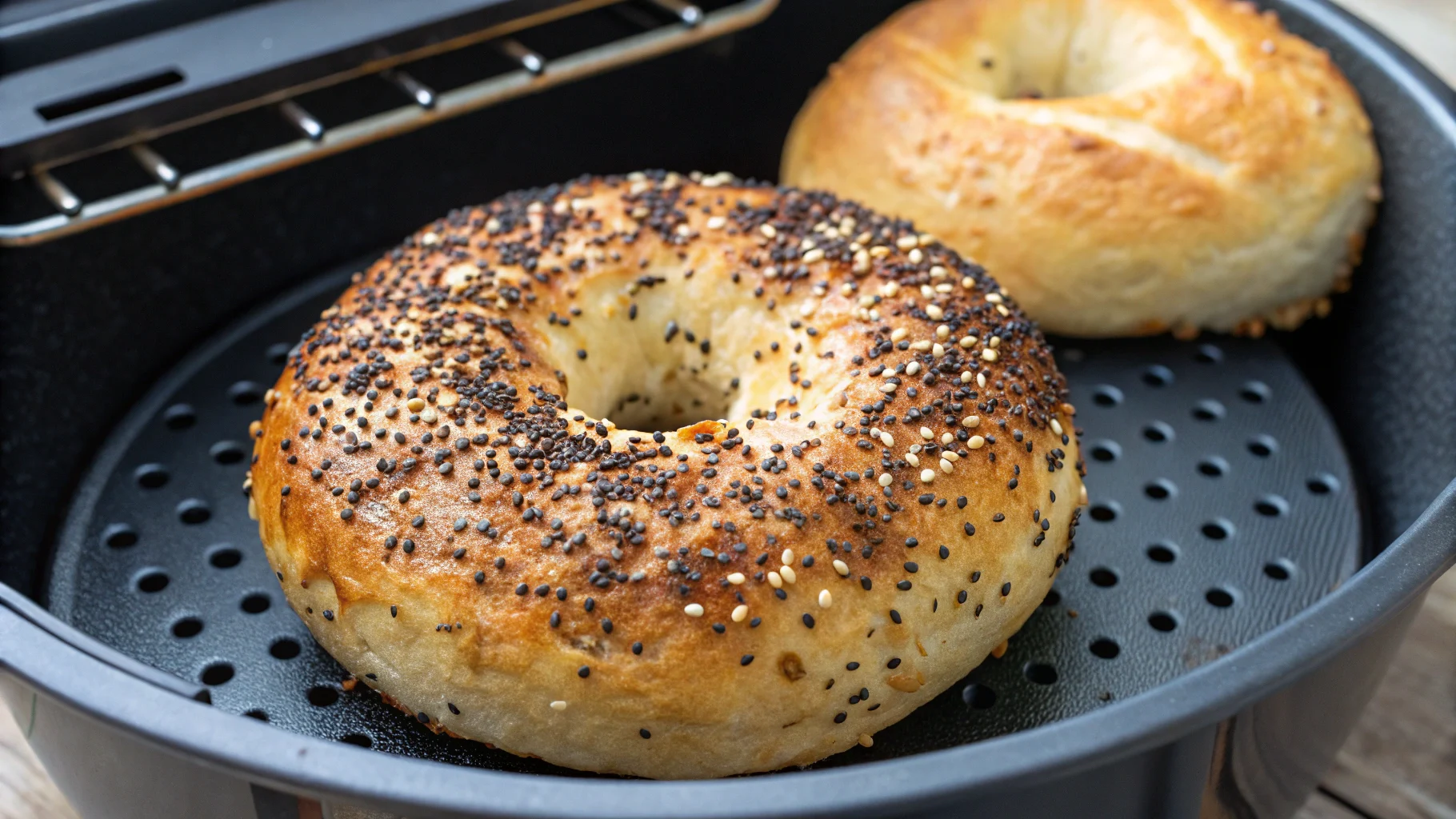High protein cottage cheese bagels recipes are a perfect example of how nutritious food can also be delicious and satisfying. I’m Savannah, the creator behind Eminent Recipes, where I blend my passion for cooking with my active lifestyle. Whether I’m meal-prepping after the gym or whipping up a quick breakfast, I believe protein-rich meals like these bagels are key to staying energized. My goal is to share simple, flavorful recipes that support your health without sacrificing taste. These high protein bagels are just one of many ways I turn everyday ingredients into something truly enjoyable and nourishing.
Table of Contents
High Protein Cottage Cheese Bagels Recipes
- Total Time: 30–35 minutes
- Yield: 4 bagels 1x
- Diet: Low Fat
Description
Whip up a batch of these quick and easy High Protein Bagels with Cottage Cheese for breakfast or lunch in less than 30 minutes – they come out perfect!
Ingredients
- 1 cup unbleached all purpose flour, or whole wheat or gluten-free mix like cup4cup, (5 oz total in weight)
- 2 teaspoons baking powder, make sure it’s not expired or it won’t rise
- 3/4 teaspoon kosher salt, use less if using table salt
- 1 cup 2% cottage cheese, excess liquid strained well (I like Good Culture)
- 1 egg white, or 1 large egg, beaten
- optional: everything bagel seasoning, sesame seeds, poppy seeds, dried garlic flakes, dried onion flakes
Instructions
- In a large bowl combine the flour, baking powder and salt and whisk well. Add the strained cottage cheese and mix with a fork or spatula until well combined, it will look like small crumbles.
- Using your clean hands, working in the bowl, knead the dough until it comes together and is smooth, tacky, but not sticky, about 2 minutes (it should not leave dough on your hand when you pull away).
- Divide into 4 equal balls. Roll each ball into 3/4-inch thick ropes and join the ends to form bagels. (or you can make a ball and poke a hole in the center then stretch it slightly)
- Top with egg wash and sprinkle both sides with seasoning of your choice.
Air Fryer Method:
- Spray air fryer basket with oil. Transfer the bagels to the air fryer basket in batches without overcrowding and air fry 280F 15 to 16 minutes, or until golden. No need to turn.
- Let cool at least 15 minutes before cutting, this step is a must.
Oven Method:
- Preheat oven to 375F. Place parchment paper or a silpat on a baking sheet. If using parchment paper, spray with oil to avoid sticking.
- Bake on the top rack of the oven for 25 minutes. Let cool at least 15 minutes before cutting, this step is a must.
Notes
- If the cottage cheese isn’t strained well, the dough may be sticky. If so, add a little more flour.
- Freeze cooked bagels wrapped tightly in plastic or foil. Reheat in foil in the oven.
- These are best fresh but can be stored in the fridge for 3 days or frozen.
- Prep Time: 10 minutes
- Cook Time: 20–25 minutes
- Category: Breakfast, Snack, High-Protein Baking
- Method: Baking
- Cuisine: American
Why High Protein Matters in Your Breakfast
The Importance of Protein for Sustained Energy
Protein plays a vital role in keeping your body fueled throughout the day. Unlike quick-burning carbs, protein digests more slowly, helping to stabilize blood sugar levels and reduce energy crashes. Starting your morning with a high protein breakfast supports muscle maintenance, keeps you feeling fuller longer, and curbs unhealthy snacking later in the day. For active individuals or anyone managing their weight, getting enough protein early sets the tone for better food choices. That’s where high protein cottage cheese bagels recipes come in—they offer the perfect balance of carbs and protein to keep your body running strong.
Why Breakfast Is the Best Meal to Boost Your Protein Intake
Breakfast is your body’s first chance to refuel after fasting overnight. Studies show that consuming 20–30 grams of protein in the morning improves metabolism, reduces cravings, and supports muscle recovery. Incorporating ingredients like cottage cheese into breakfast bagels is a simple, tasty way to hit your morning protein goals.
Health Benefits of Cottage Cheese in Bagels
Nutritional Profile of Cottage Cheese
Cottage cheese is a powerhouse ingredient that brings serious nutritional value to your breakfast. Packed with approximately 12–15 grams of protein per half-cup serving, it’s an excellent choice for boosting daily intake. It’s also low in fat (especially when using low-fat or non-fat varieties), making it ideal for high-protein recipes that are still heart-healthy. Cottage cheese contains casein—a slow-digesting protein that feeds your muscles over time—along with essential nutrients like calcium, vitamin B12, phosphorus, and selenium. Incorporating it into high protein cottage cheese bagels recipes not only elevates flavor and texture but adds a protein boost without extra effort.
How Cottage Cheese Supports Muscle Gain and Satiety
What makes cottage cheese unique is its ability to promote lean muscle development while also aiding in appetite control. The high protein content fuels muscle repair, especially when consumed post-workout or first thing in the morning. Its slow digestion rate helps maintain satiety, reducing mid-morning hunger spikes and minimizing calorie overconsumption throughout the day. In a bagel, cottage cheese doubles as both a protein source and a moistening agent, giving you a chewy texture and rich flavor. For anyone looking to build muscle, maintain energy, or feel fuller longer, it’s a smart, functional choice for breakfast and beyond.
Understanding Cottage Cheese Bagels
Essential Ingredients List
To make truly satisfying high protein cottage cheese bagels recipes, you need ingredients that deliver on both flavor and nutrition. Here’s what to include in your protein-packed dough:
- Flour: This recipe works with unbleached all purpose flour, whole wheat flour or gluten-free flour mix such as Cup4Cup.
- Baking Powder: For rising, make sure it’s not expired.
- Kosher Salt: Also helps flour rise, I use kosher salt, if you use table salt you make have to cut in half.
- Cottage Cheese: Use 1 cup 2% cottage cheese (I like Good Culture) and strain it in a mesh sieve so it’s thick.
- Egg: 1 large egg or egg white, beaten (to help the toppings stick) If you can’t eat eggs, you can omit and just press them into the dough.
- Optional toppings: If you like a plain bagel, no toppings needed. But if you like seasonings, try this with everything bagel seasoning, sesame seeds, poppy seeds, dried garlic flakes, dried onion flakes, etc.
This combo creates a dough that’s simple, versatile, and delicious—without traditional yeast or hours of rising.
Step-by-Step Guide: Searing, Slicing, and Assembling
Note: This guide adapts traditional methods to suit cottage cheese bagels, which don’t require boiling like classic bagels.
- Combine Dry Ingredients: In a large bowl combine the flour, baking powder and salt and whisk well.
- Strain Cottage Cheese so it’s Thick: Add the strained cottage cheese and mix with a fork or spatula until well combined, it will look like small crumbles. If you don’t strain it well, the dough will be sticky.
- Knead: Using your clean hands, working in the bowl, knead the dough until it comes together and is smooth, tacky, but not sticky, about 2 minutes (it should not leave dough on your hand when you pull away).
- Form Into Bagels: Divide into 4 equal balls. Roll each ball into 3/4-inch thick ropes and join the ends to form bagels. (or you can make a ball and poke a hole in the center then stretch it slightly)
- Egg Wash: Brush with egg wash and sprinkle both sides with seasoning of your choice.
- Air Fryer Method: Spray air fryer basket with oil. Transfer the bagels to the air fryer basket in batches without overcrowding and air fry 280F 15 to 16 minutes, or until golden. No need to turn. Let cool at least 15 minutes before cutting, this step is a must.
- Oven Method: Preheat oven to 375F. Place parchment paper or a silpat on a baking sheet. If using parchment paper, spray with oil to avoid sticking.
Bake on the top rack of the oven for 25 minutes. Let cool at least 15 minutes before cutting, this step is a must.
This approach is fast, high-protein, and doesn’t require yeast—perfect for busy mornings.
Common Mistakes & How to Fix Them
Using the Wrong Flour or Cheese Type
One of the biggest pitfalls in high protein cottage cheese bagels recipes is choosing the wrong flour. All-purpose flour is fine, but for a high-protein goal, it’s better to use almond flour, oat flour, or whole wheat flour. Almond flour boosts protein but can make the dough more delicate, so combine it with a binding agent like egg. Oat flour adds fiber and a mild sweetness, perfect for both sweet and savory versions. As for cottage cheese, avoid the chunky, watery types. Use smooth, low-fat or 2% cottage cheese to ensure consistent moisture and structure in the dough.
Overbaking or Underbaking Problems
Cottage cheese bagels can be tricky to bake just right. Overbaking leads to a dry, tough texture, while underbaking leaves the center gummy. To avoid this, always preheat your oven fully and use the toothpick test—if it comes out clean, they’re done. Bake at 375°F for 20–25 minutes and allow them to cool before slicing. If your bagels brown too quickly, tent them with foil halfway through baking. And if they come out too wet, reduce cottage cheese slightly next time or increase the flour by a tablespoon.
Want more sweet and savory recipes like this? Follow us on Facebook for daily dinner ideas, cooking tips, and behind-the-scenes moments from Eminent Recipes.
See how others are plating this dish on Instagram! Tag your version with #EminentEats and get featured.
Love collecting recipes? Don’t miss our latest pins on Pinterest—perfect for saving your favorite meals in one spot.
FAQs
How much protein is in a cottage cheese bagel?
A typical cottage cheese bagel contains around 15–20 grams of protein, depending on the recipe and added ingredients like eggs or Greek yogurt.
What can I add to cottage cheese to increase protein?
You can stir in unflavored whey protein powder, Greek yogurt, hemp seeds, or chia seeds to easily increase the protein content of cottage cheese.
How do I add more protein to a bagel?
Add toppings like nut butter, eggs, smoked salmon, or a spread made from Greek yogurt. Using protein-rich flour or cottage cheese in the dough also helps.
Is cottage cheese good for bagels?
Yes! Cottage cheese adds moisture, protein, and a creamy texture to bagels while keeping them lower in fat and high in satiety.
Conclusion
High protein cottage cheese bagels recipes aren’t just a trend—they’re a smart, satisfying way to fuel your day. By combining the creamy richness of cottage cheese with nutritious, protein-packed ingredients like eggs, almond flour, or Greek yogurt, you get a breakfast that supports muscle health, boosts energy, and keeps you full longer. Whether you enjoy them savory or sweet, toasted or fresh, these bagels fit easily into any lifestyle, from busy mornings to post-workout meals. Plus, they’re incredibly easy to make and customize. Once you try them, they might just become your go-to high-protein staple.
Don’t miss our guide to Teriyaki Pineapple Chicken Rice Stuffed Peppers and Jerk Chicken Pasta Alfredo—great protein-packed ideas to complement your meals!

